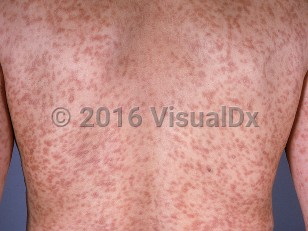Mastocytosis is a term broadly referring to tissue mast cell hyperplasia. This proliferation is generally classified as either cutaneous, with or without systemic involvement, or systemic without cutaneous disease. Mastocytosis most commonly manifests as cutaneous disease (
urticaria pigmentosa,
mastocytoma), seen more often in children with involvement typically limited to the skin. In contrast, adult cutaneous variants frequently have systemic disease.
Systemic mastocytosis is a less common myeloproliferative variant that is further stratified based on clinical criteria as well as on associated mutations, namely activating
c-kit mutations. In general, there is no age or sex predilection.
The 2016 World Health Organization (WHO) classification includes:
- Cutaneous mastocytosis:
- Cutaneous mastocytoma
- Maculopapular cutaneous mastocytosis (urticaria pigmentosa)
- Diffuse mastocytosis
- Systemic mastocytosis:
- Indolent systemic mastocytosis
- Smoldering systemic mastocytosis
- Systemic mastocytosis with hematologic neoplasm
- Aggressive systemic mastocytosis
- Mast cell leukemia
- Mast cell sarcoma
Patients first need to be assessed to determine whether they have cutaneous mastocytosis or systemic mastocytosis. Cutaneous mastocytosis most commonly affects children. Systemic mastocytosis typically affects adults. All adults with mastocytosis need to have a full workup to exclude systemic mastocytosis.
In adults, cutaneous mastocytosis is defined by:
- Typical skin lesions.
- Positive Darier sign and/or a positive skin histology.
- Absence of criteria sufficient to diagnose systemic mastocytosis in staging examinations.
Once the diagnosis of cutaneous mastocytosis is established, the cutaneous findings can be subclassified as above.



